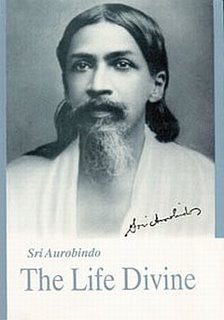 |
The Triple Status of Supermind
Poise C
The Secondary poise of the Supermind
While the first poise in the unfolding of Knowledge-Will that manifests the creation is that of the unmanifest Sachchidananda and the subsequent poise is that of the primary Supermind which holds the creative idea and vision as an in-built program, the next poise is the secondary, apprehending status of the Supermind where the in-built program of creation that is held in the primary Supermind is geared for execution. The triune yet unitary complex of Sachchidananda (Existence – Consciousness-Force – Bliss) starts getting differentiated without losing their linkage and without abrogating their oneness. This movement of differentiation implies a dynamic and a totipotent Power at work, a Power that is the prime-mover in the realms of the Infinite. Sri Aurobindo explains that this creative Power is an exceptional Power that is the ‘pure’ Power of existence and is represented simultaneously by ‘Consciousness’ and ‘Force’ which are its twin essential aspects (The Life Divine, pg 156). With the unrolling of the manifestation, the twin aspects of the Pure Power of existence get expressed as ‘Knowledge’ and ‘Will’ that need to be understood in cosmic parlance as Universal Knowledge and Will (and not in terms of the ordinary mental working where they do not exist integrally but are separated and often in conflict).
|
|
The original Consciousness and Force that get expressed as the Universal powers of ‘Knowledge’ and ‘Will’ to create a world of relations need a matrix for manifestation. This creative matrix is provided by the Supermind projecting ‘space’ from a non-spatial Reality through an objective extension of Consciousness and by projecting ‘time’ from a timeless Reality through a subjective extension of Consciousness. Thus, Knowledge and Will ‘must be one , infinite, all-embracing, all-possessing, all-forming, holding eternally in itself that which it casts into movement and form. The Supermind then is Being moving out into a determinative self-knowledge which perceives certain truths of itself and wills to realize them in a temporal and spatial extension of its own timeless and spaceless existence’ (Ibid).
It is interesting to understand the sequence of events triggered off in the realm of the secondary or apprehending Supermind. The moment it gives rise to the two dyadic principles of ‘Knowledge-Will’ and ‘Space-Time’, it charts out the appearance and consolidation of dynamic points of support or eddies representing ‘concentrations’ of Consciousness. In a way, these points of support are unique in nature and though all points are the same in essence, they are differentiated from each other representing a rich, variegated and diversified manifestation. These points of supports are behind each and every created form and operative force and therefore behind each plane of consciousness and in the case of the human being, each individual point supports the ‘individual divine’ or ‘Jivatman’ which is the unmanifest being behind each manifested individual. One cardinal question in metaphysical yoga psychology is whether all Jivatmans would be the same. They are same in soul-essence and differ only in supporting different soul-forms. In a way, though it is implied, it is yet difficult to use the plural form of the Jivatman, a reason why Sri Aurobindo often used the term ‘multiple Divine’. [‘The Jivatman …Knows itself as one centre of the multiple Divine...’ (CWSA, Vol.35,pg 128)]
‘This, then, is the nature of the Divine Consciousness which creates in itself all things by a movement of its conscious-force and governs their development through a self-evolution by inherent knowledge-will of the truth of existence or real-idea which has formed them. The Being that is thus conscient is what we call God; and He must obviously be omnipresent, omniscient, omnipotent. Omnipresent, for all forms are forms of His conscious being created by its force of movement in its own extension as Space and Time; omniscient, for all things exist in His conscious being, are formed by it and possessed by it; omnipotent, for this all-possessing consciousness is also an all-possessing Force and all-informing Will. And this Will and Knowledge are not at war with each other as our will and knowledge are capable of being at war with each other; because they are not different but are one movement of the same being. Nor can they be contradicted by any other will, force or consciousness from outside or within; for there is no consciousness or force external to the One, and all energies and formations of knowledge within are not other than it, but are merely play of the one all-determining Will and the one all-harmonising Knowledge. What we see as a clash of wills and forces, because we dwell in the particular and divided and cannot see the whole, the Supermind envisages as the conspiring elements of a predetermined harmony which is always present to it because the totality of things is eternally subject to its gaze.’ (The Life Divine, pg 157)
Date of Update:
29-Jun-15
- By Dr. Soumitra Basu
|

